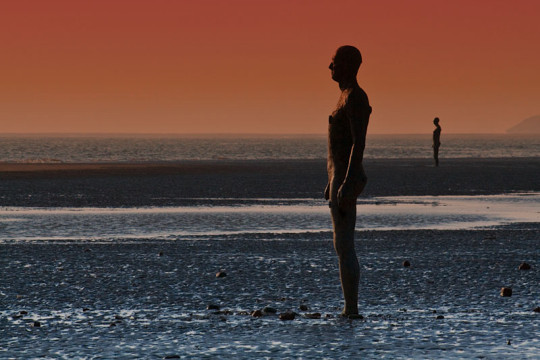
There are several thoughts that are really just addendums to my last post, and then a brief discussion of a couple popular new TV shows that seem worth looking at in terms of their popularity.
But first:
One of my very favorite artists, among the very best I know, is photographer Frederike Von Rauch, who lives and works out of Berlin. Rauch works with only an analog camera, and changes nothing in her enviornment. She simply waits. She waits for the right conditions, and her own inner clock. In this sense she is another version of Trevor Paglin. Rauch keeps the camera at eye level, and never shoots if the sun is shining. It is a kind of study of space, and of architectural space, even when there is no architecture.

Frederike Von Rauch, photographer
Like Paglen, the photographs are silent. These are dream spaces, but also theatre spaces. They are the dreams of a twenty first century in which, increasingly, the public senses some things have gone missing. They are silent enigmatic cryptic, tenebrous and yet for all the sense of darkness, the bulk of each photo is made up of white walls, stairs, curtains, roadways or on occasion, sky. It is a white of great solidity, a sibylline authority, and is a white sort of tension, as opposed to a black tension. In blackness resides the cosmos, infinity, the milky way and in white, perhaps, at least the white of Von Rauch, is the relfex hiding of terror, It is also more silent than black. Black can be silent. White can be absolutely silent. White is more immediate.

Frederike Von Rauch, photography
Just as an aside:
When work (or the artist) declare that their work is about *perception and illusion*, or its about *gender roles* or its about *time*…..or any of a hundred other invented themes, you should assume the work, then, to be minor if not just bad. ALL good work is about all those things. Is there any painting of any stature at all that is not abouut *time*? Or perception? Or even gender roles— though in terms of these “issues”, my feeling is its best to write an essay, organize a protest. Art that decides to be ***about*** a theme is going to be bad.
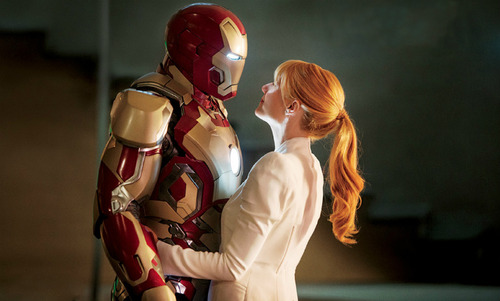
Iron Man 3, Dr. Shane Black, 2013
I have written about Jenji Kohan’s previous show Weeds on a couple occasions, once in a dialogue with Molly Klein. I had sort of intended to avoid writing about her new show, Orange is the New Black, based on Piper Kerman’s memoir about a year spent in a woman’s federal prison (minimum security). Now, the show has already been pretty well dissected by Aura Bogado, and others, but I still think a couple comments are in order. The show features a trans-gender black character who is played by a trans-gender actor. I cannot tell you how many times I have already heard all about how wonderful and progressive such practices are, in both writing and casting, and how many times liberals I know have gone out of their way to tell me to watch the show. And this led me to a couple observations. First; yes it is a racist show. It is a white supremicist show. It is made by a white Jewish woman from Beverly Hills. It is produced by a white owned and managed corporation. Kohan’s previous show was very funny, sharp, and for a while it was also sort of promoting a posture of cultural opposition. By the end however, the more conservative and punitive feelings of the show creator began to emerge. The final episode of the entire series, a long 8 seasons, was a mean spirited revenge on Nancy Botwin (the character portrayed by Mary Louise Parker). The anti feminism that had targeted the character of Celia (played by Elizabeth Perkins, who quit the show, in fact) was transferred to Nancy. The message was that traditional motherhood was good, promescuity was bad, taking drugs was bad, and forgiveness not something worth giving to those in need of shaming (i.e. Nancy). One had followed the modest rewards of this comedy rooting for Nancy, a non conformist single mother going up against the system. The revenge on Nancy was always there, sort of hovering, and finally it came out in astonishing fashion in that final episode. Now, the new show is meant, clearly, to be kept light. This is not Oz (and trust me, even THAT show was pretty much a kitsch version of the US prison system).
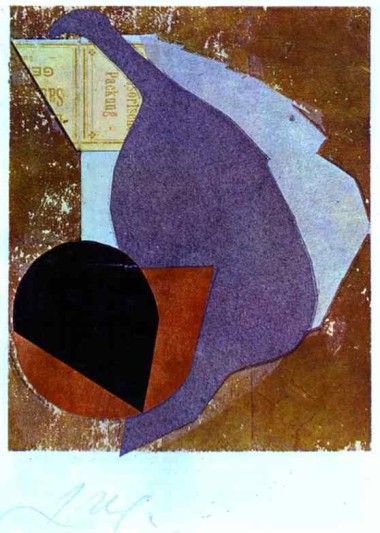
Jean Arp, 1912
What I want to say, after this long prologue, is that for all Kohan’s alleged progressiveness, there remains a stark conservative core of ‘white people as more important’ running through all her projects. White and Jewish and rich, and while tolerant, it is a highly qualified tolerance, a tolerance that is paternalistic (or maternalistic), it is class superiority expressed in a travelogue comedy about a WHITE woman in the joint…among all those, you know, dark scary people. The scary characters among the prisoners are black or brown. The more scary characters are the corrupt white guards. There is a lip service paid to how these underclass women of color found themselves in prison, but such flash backs only serve, really, as a form of titillation. More touring of the black underclass, and a source of humor for the show. Its a fish out of water format. No amount of tolerance about trans people or bi-sexuality (thrown out there with a fair amount of nudity…meaning bare breasts) erases the core values on display. It is a minstrel show. I would be curious to know if black audiences feel the same about this show as it seems do white audiences. Opportunistic queer characters can probably be counted on the plus side of the ledger, even in this context, but I’m not even sure of that. What is rather overwhelmingly clear is not just the issues of race, but of class. This is the world of the underclass, where Kohan sees only exotic and strange wildlife. Some scary, some amusing, some sort of pathetic. And then framing the representation of prison in a pretty light hearted comedy… well, it feels oddly callous. Am I saying you can’t make a great liberating comedy about prison today? Of course not. I am saying this is not that comedy. No matter how one reads this show, it comes up as dishonest, as condescending, and patronizing.

Orange is the New Black, 2013
A quick google search will yeild one page after page after page of rave reviews of OISTNB. In fact, Bogado’s piece is a singularly sober analysis amid all this, in stating the obvious. But here we run into a bigger discussion; and that is that the public today is predisposed to defend their entertainments. They live in a culture of extreme identification not just with individual characters, but with cultural product per se. The public identifies with the “show”. They feel possesive of their favorite shows.
http://www.thenation.com/blog/175786/white-new-white#axzz2cEw1fMKn
This identification creates certain recurring mechanisms in how narrative is consumed. It is becoming increasingly clear to me these days, that the general public does not read narrative except as advocates for *entertainment* over all. In other words the public identifies not just with characters, or with shows, but with the vast complex of commodity production (speaking here of cultural production). The subject position is one of advocate. People will distinguish between actors they like or don’t like, with shows or genre they like more or like less, but there lurks a backdrop of real fear lest they be deprived of these entertainments. THAT is actual backdrop at work in these endless pages of adulation for OITNB, or Breaking Bad, or Game of Thrones. These products define almost all dialogue and discourse. And while I am constantly writing on questions of aesthetics, and of what I see as a real need to start engaging with artworks over all in more sophisticated ways, it remains true that on one level, the hegemony of corporate product is now so acute that it feels increasingly impossible to teach aesthetics without first posing questions that challenge the apparatus of “entertainment”. The culture industry is just that. It is in the business of manufacturing a *real*, of reproducing the values and beliefs of the ruling class. When Chomsky and Ed Herman wrote Manufacturing Consent thirty years ago, they introduced ideas that are far more prevasive today, and that have become far more effective.
From an interview with Chomsky in 1992:
“QUESTION: When we talk about manufacturing of consent, whose consent is being manufactured?
CHOMSKY: To start with, there are two different groups, we can get into more detail, but at the first level of approximation, there’s two targets for propaganda. One is what’s sometimes called the political class. There’s maybe twenty percent of the population which is relatively educated, more or less articulate, plays some kind of role in decision-making. They’re supposed to sort of participate in social life — either as managers, or cultural managers like teachers and writers and so on. They’re supposed to vote, they’re supposed to play some role in the way economic and political and cultural life goes on. Now their consent is crucial. So that’s one group that has to be deeply indoctrinated. Then there’s maybe eighty percent of the population whose main function is to follow orders and not think, and not to pay attention to anything — and they’re the ones who usually pay the costs.”

I think today that when people think of propaganda, they think of the sheep-like 80% that mindlessly read tabloids or watch FOX news, or the latest soap operas, etc. But in fact, as Chomsky says, it is this relatively educated class, which today in the US means those self identifying as liberal, and mostly white, that work in the service of validating this system of propaganda. As Chomsky says later in that same interview….
“In fact, if the system functions well, it ought to have a liberal bias, or at least appear to. Because if it appears to have a liberal bias, that will serve to bound thought even more effectively.”
This apparatus has now successfully demarcated the parameters of discourse. There are obvious examples of this which can be seen in the rabid militarism on display, the constant hammering home of abstractions such as patriotism and freedom, and which often actually run counter to a good part of the liberal value system. But such is the nature of this hegemony that these contradictions are subsumed, without much disruption, by the larger prevailing worship of the apparatus itself. There is still a good deal of just mind dulling junk out there, but the more pernicious production occurs at the level of the stuff aimed at this educated market. One will hear a lot about liberal bias. This is a useful trope for that 80%, and it gives them someone to hiss and boo. They are pandered to in this predjudice, too. But in fact the liberal educated class are far more important to the ruling class system of domination and the results have been to narrow discussion to such a degree that a topic like racism and the prison industrial complex is being debated in terms found in Jenji Kohan’s latest comedy show. That anyone can say, with a straight face, that Orange is the New Black is, first, not racist, and second, is actually anti racist, is actually humanizing people of color or marginalized classes in general, is stupifying. Institutional racism is now defined in terms from a Jenji Kohan product, produced by Netflix. This is achieved by having created this almost animal bonding with the ‘apparatus’. There is a strong emotional connection that people feel with the culture industry. An emotional bonding and set of projections that arrive at a place where this liberal white audience is so invested in their entertainments that they will mobilize to defend them. The educated class is more prone to action in defense of their right to have HBO or Showtime than they are to even start to think about dismantling the prison system.

Now, as this pertains more specifically to artworks. To what has come to be defined as “art”, the tidal change has created a vast audience prone to and indoctrinated to consensus. To agreement with what the entertainment apparatus spews out. Designations are manufactured and have an incredible durability and traction. If a show or actor or movie is identified as *popular* there is immediately an indelible fear of expressing criticism of said *popular* product. The gatekeepers of culture, those always in various ways corrupted, the curators and managing directors and professors and Deans have ceded authority to media. The individual audience member no longer even has much idea of what they feel, really, in their consumption — and even if they don’t respond in a way familiar to themselves with, say, the watching of Lena Dunham, that slight confusion is put aside easily enough in order to join in the general chorus of approval. Iron Man 3 was a massive box office hit this year. Written and directed by Shane Black, the film is so thin on story, let alone character, as to almost not have a story. It is a giant CGI spectacle with what is just a sort of prospectus for a narrative, told in a short hand of familiar codes within a highly familiar franchise that has already been established as popular. Does the individual audience member actually enjoy this film? That’s an interesting question. I don’t think that enjoyment is even a category anymore in the context of these big budget products. It’s like asking if you enjoy Church. The film has a recognizable tone, a sort of wise guy snark with plenty of *cute* effects on display, and is so fast paced that about half way through there is no longer a story even operative. Fans will defend this by arguing that it’s ‘just a comic book’, after all. They are told, directly by marketing, that to expect complexity is unreasonble and even boorish. It is loud, fast, colorful, and it is only a very slightly different copy of the first two installments of this franchise. It literally no longer matters what is actually on the screen. The context has pre-approved this block buster and it would be a sign you’re a total buzz kill sort of person to complain about it.
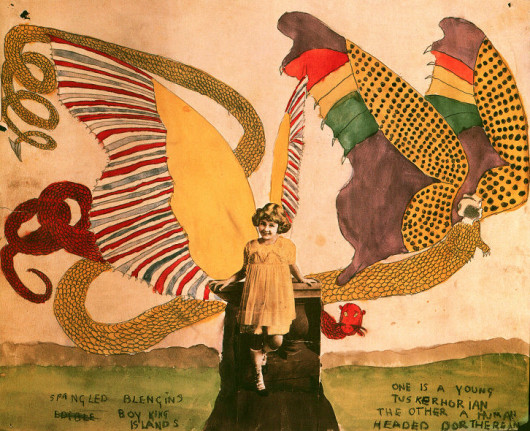
Henry Darger
And indeed, on one level there IS nothing to critique. There is really only the entertainment apparatus to analyse, and that sort of analysis is now so stigmatized and ridiculed that to attempt such a dialogue would be met with only hostility. This love affair with the industry that manufactures this stuff runs deep, and it appears at all levels of discussion about the arts. A system that has now ordained a show such as Orange is the New Black, as social commentary, or that validates corporate built reactionaries such as Jay Z. as socially committed, is then going to be able to both marginalize real discourse about US state violence, and the vast and still growing prison population, and at the same time erect non-threatening and non critical artworks (Marina Abramovich, or Darin Aronovsky, et al) as models for approval. What happens when an Aronovsky (or whoever) is validated, and rewarded and applauded, is that the form of such infantile and limited narrative become templates associated with “good”. Screenwriting workshops teach that Black Swan is a model for excellence. This is that 20% educated class now being directly targeted, and after about seventy films, of equally poor quality, are churned out and discussed and analysed and debated, there becomes entrenched a system of values and aesthetic codes from which deviation is not allowed. The mechanisms of consensus also lead to what I have seen as the new ‘workshop’ model for the arts. It is pronounced in writing mediums, but true enough in performance and visual arts, as well. Everyone has an opinion and everyone gets to express it. This functions under the aegis of anti-authoritarian or anti hiearchical education. In fact it is MORE hierarchial because it is validating, by extension, a system that has defined (via propaganda) what is good and what is bad. It validates lack of education, lack of knowledge and in general, ignorance. It becomes highly essentialist, too. It is the idea that even unformed opinions matter, somehow. Now, given the absolute degrading of institutional learning, there is certainly no argument from me about a process that will somehow mediate the authority of reactionary professors. There also needs to be made clear that there is a distinction between the collective work of groups like The Living Theatre, or Kanter’s company, or any number of other groupings of artists looking toward a rigour denied them at insititutions, and the user friendly art-as-hobby meetings of near countless poetry and writing workshops (or short stories, or theatre, or, etc etc). This, however, is the rise of a certain attitude toward the arts as it is expressed in this comparetively new model of professionalized creativity. MFA programs, writing workshops, theatre workshops (of which I have taught many) and the architecture of appreciation, the inculcating of hobby-ism, and of courtesy among professional collegues, and indeed, the by products of a certain end of PC culture, all helped erode any avante garde. The workshop mentality has morphed into a tepid porridge of mutal back slapping and agreement. This is intertwined with how this affulent white educated class intersext with feminism, diversity, and gay rights. Things begin to enclose the discourse. The battleground of identity politics plays out here, in its more regressive forms, and what one gets is institutional learning compromised by an elite class and by economic dependency on corporate donars, as well as culturally, a diluted and infantalized system that rewards compliance. Radical voices are, of course, marginalized. The workshop culture is reactionary, finally. Revolutionary sensibilities are a threat to the system, to the greater hierarchy of white supremicism, and Imperialism. The arts have been almost completely domesticated, and an atmosphere of self help sociological therapy pervades most institutions. Minor artists feel no need to learn more. Any form of apprenticeship is rare. Equality in this context means acceptance of mediocrity.
There is again, what Adorno called the untruth of artworks. In a reified capitalist system, a Balanchine emerged as tyranical and irrational, but also produced works of genius. This is the dialectic of Capital. In a sane world, a world without repression or privilege, such untruth would not have the need for such reaction. At least one might assume. Perhaps…but today, the system spews out ever greating percentages of junk. And against this self involved liberal autism culturally is a backdrop of total surveillance, a growing domestic police state and continuing Imperialist bloodbaths around the globe. One cannot, finally, see Iron Man 3, the OITNB as not part of the propaganda that occludes the real horrors, and helps reproduce a dishonest frame for even the start of a dicussion. The prison complex is racist. The courts are racist. The cops are racist. The entire US Imperialist war machine is racist. It is a racist country, to its core. But the dialogue is about Jenji Kohan or Bryan Cranston.
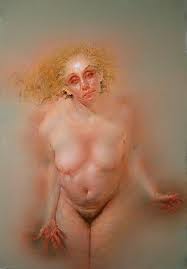
Anne Harris
There is an additional perspective from which it is useful to view such entertainments, and the “liberal” assent to the war on the poor, and most intently, on the underprivileged youth. From John W. Whitehead:
“Moreover, as suspensions and arrests for minor failings and childish behavior become increasingly common, so does the spread of mass surveillance in our nation’s schools. In fact, our schools have become a microcosm of the total surveillance state which currently dominates America, adopting a host of surveillance technologies, including video cameras, finger and palm scanners, iris scanners, as well as RFID and GPS tracking devices, to keep constant watch over their student bodies.
For example, in May 2013, Polk County School District in Florida foisted an iris scanning program on its students without parental consent. Parents were sent a letter explaining they could opt their children out of the program, but by the time the letter had reached parents, 750 children had already had their eyes scanned and their biometric data collected.
Making matters worse, these iris scanning programs are gaining traction in the schools, with school buses even getting in on the action. As students enter the school bus, they will be told to look through a pair of binocular-like scanners which will either blink, indicating that the student is on the right bus, or honk, indicating that they’ve chosen the wrong one. This technology is linked with a mobile app which parents can use to track their child’s exact whereabouts, as each time their eyes are scanned the parent receives a print out with their photo and Google map location, along with a timestamp. Benefits aside, the potential for abuse, especially in the hands of those who prey on the young, are limitless.
Insiders expect this emerging industry to expand beyond schools to ATMs, airports, and other high security areas within the next few years. It’s definitely big business. The school security industry, which includes everything from biometrics to video surveillance, was worth $2.7 billion in 2012 and is expected to grow by 80% over the next five years and be worth $4.9 billion by 2017.”
As I wrote about last posting, this is almost all junk technology, and it is in the hands of undertrained authoritarians, which combine to create an almost arbitrary police state. It is big business these days, though. Public schools resemble nothing so much as prisons and students are being introduced to control measures and punishment at an earlier age and taught that anything but total compliance can land them in jail. Propaganda now operates with specific target demographics. A white affulent and semi educated liberal class can enjoy prison comedy courtesy of Jenji Kohan, while inner city and rural poor teens (and younger) are provided with Orwellian systems of oppression and control. Children who attend high schools (such as Beverly Hills High School for example) need not worry about arrest or lockdown, and probably get to share the amusement of that twee white girl and her problems with scary Crazy Eyes (the black and exaggerated lesbian pursuing our heroine).
So, in the context of culture and art, for that retains a critical importance if coming generations are to be able to think independently at all, to be able to even imagine what an autonomous and creative life might be like, it is worth starting a discourse that interacts with and reveals the growing emotional attachments to the narcotic of corporate media commodities. Kim Kardashian has millions of twitter followers. The educated white class laughs and ridicules such worship of “dumb” celebrities — but themselves grant exemption for their own adoration of a favorite TV show; and it is this degrading of what “art” actually means, it is the artistic inflation bestowed on the latest HBO franchise, or Oscar nominated film, that drives a good portion of white surpremacist (liberal, educated, affulent) mindset. The white hierarchy of power is never ever not the deciding framework for corporate TV.
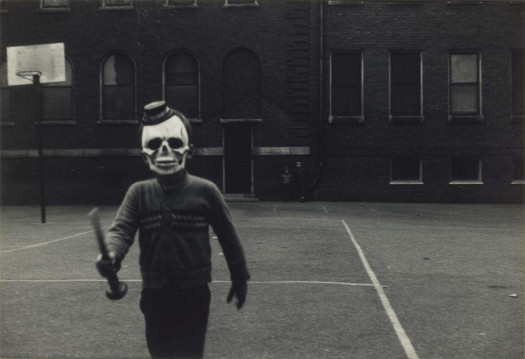
There is good work out there. One has to search for it most of the time. Not always, but usually. I was thinking of Henry Darger this week. The reclusive writer and artist, diagnosed as feeble minded when still a child, he eventually escaped the home for troubled boys (he probably also suffered Tourette’s Syndrome) he found work in Chicago as a janitor, and it is in that way he lived the remainder of his solitary life. Only after his death in 1972 did his landlords discover the volumes of written work, and his many collages and drawings. Exactly the degree of Darger’s importance is debatable, but there is little question that the work is among the more disturbing and uncanny of the entire 20th century. It is in the work of strange isolated figures such as Darger that one finds the truth of culture. It is also worth revisiting Darger as an antidote to mass corporate distractions such as Hollywood produces and for which the public increasingly feels an almost aggressive loyalty.

Henry Darger

Inexplicably the rather reminds me if Courbet. Ryan pointed out on twitter that the bad husband us exploiting the stories of the prisoners …its a self indictment embedded in the show. This pseudo confession as alibi. The producers know the audience well …that’s all they need to justify their indulgence of the sadistic and contemptuous entertainment. A tiny gesture if self consciousness. On they know they’re racist and exploitative so its OK. Like zizek disarming criticism by preemption ” my favourite racist theory is. .”
Did you ever see Klute by the way?
The Darger reminds me of Courbet that should say
yes, you know I had meant to mention that bit of pseudo auto-critique. The husband…who is gently satirized, then has pangs of guilt about exploiting the prison context. This sort of device actually, of course, makes it all much worse. If you KNOW up front that this sort of story and location is impossible to NOT exploit, but you do it anyway, there is a worse indictment of your actions coming. Weeds was full of those sort of po mo critical devices. But the brunt of the anger in Kohan, was realized in that final episode. It was also her deep sense of superiority — like many hollywood brats. They are the new priest class.
— Darger is fascinating, and there are traces of Dubuffet, and Im sort of always a sucker for all those outsider artists…and so many share this graphomania, and a fascination with dolls. Its part of how disturbing dolls and marionettes are….we all share some attraction to that quality which comes out in guys like Darger, or Howard Finster, or George Widener.–.. or the Ned Chand Saini phenomenon….which ends up a form of dolls. Its very odd and unsettling. —
Anyway………I remember loving Klute…but ive not seen it in a long time.
and molly made a comment to me about how in Iron Man capital and labor are no longer distinguished……HE made the suit! And this is the unreality of studio film that is so deeply established now and I think the public forgets that such things are fantasy…..that what is presented is a comic book….and it creates an unstable sort of world view…semi conscious in the audience, where the fantasy IS seen as fantasy, and also NOT seen as fantasy. Its like “I could make such a suit” if i was motivated etc etc. Forgetting the suit is a fantasy construction. And forgetting that only billionaires have such freedom.
u should note this observation about iron made was made by a very bright sixteen year old and related to me
this elysium looks horrid too, same evasion of production and class
its not that difficult to make sensible action films>>>chicken run always comes to mind when i look at this fascist shit people accept, excusing it in ways that sound psychotic
iron man
http://www.motherjones.com/mixed-media/2013/05/film-review-iron-man-3-politics
quote—In the DVD commentary of the first Iron Man, Marvel frontman Stan Lee discusses why he created the character in the first place. He wanted to piss off some hippies:
“It was the height of the Cold War. The readers—the young readers—if there was one thing they hated it was war, it was the military, or, as Eisenhower called it, the military-industrial complex. So I got a hero who represented that to the hundredth degree. He was a weapons manufacturer. He was providing weapons for the army. He was rich. He was an industrialist. But he was good-looking guy and he was courageous…I thought it would be fun to take the kind of character that nobody would like—that none of our readers would like—and shove him down their throats and make them like him.” —unquotee
I should note that should say
the guy who made Elysium made District 9….a not uninteresting film in fact. I was sorry to see he was doing big budget studio stuff. District 9 at least had an apartheid sub text…..and was nicely shot for no money. It only goes to prove that one over-values small mercies in film these days.
Anyway — well, right on iron man. I think its fascinating that this very right wing low brow comic book stuff is now so digestible for the liberal public. they do back flips to make it into some sort of anti war film . I actually had someone say that to me about the first Iron Man….how anti war it was, etc etc. So, what was offensive in obvious ways in 1967 is now treated in much the way Dickens is treated or Henry James. Its as if these right wing fascists….like mickey spillane, too, these hard ass republican white guys are now revered as some originary font of wisdom.
it seemed to me district nine was all screwey – another cuckoo. the oppressed are new arrivals; he seemed to want to invent a scenario where he could show black south africans as xenophobic racists. the Other is a horror to us, unlike us. it seemed a very conceding sort of liberal apology for apartheid – a suggestion that its the result of some natural human tendency to ‘fear the alien’. elysium now seems even worse – ayn randish regarding the elites power; there is no production and no social agency on the part of the immiserated; it makes little sense>>>a world where elites create everything and somehow have alll this stuff and food magically. These seem basic white south african visions of the world ….the creative white settler rulers are not nice but they really have made the desert bloom or whatever, brought German Spirit and its creativity and prodictyivyt to the land of the lazy and incapable> people are syaing elysium would be radical if the hero werent a white male action star – i dont see how i think there is in him this well meaning liberal uneasiness with ineualqqity and oppression but no understanding and a fundamental blindness to propduction and expropriation and exploitation that is the basis of a deep and ineradicable white supremacy that therefore cannot help but assume audiences disgusted by the propertyless majority who have to be taught to care about them
I read District 9 differently, but i agree it was pretty confused in places. The problem is…..while I think the critique was liberal, and i think he saw apartheid or fear of immigrants as wrong, there is always (or usually) in these films with aliens, a sort of strange default position on race and eugenics and what makes for the “other”…..for the construction of the other and it always skips over (as you say) any class analysis. But more than that is the biologism that lurks in there. It subsumes whatever class dialogue might have been hinted at, or even a position that was anti-authoritarian. I guess I feel pushed into a freudian reading of such films, usually. There is this deep repressed self loathing and fear of sexuality and women.
on OitNB, the (jewish) fiance-as-exploitative-writer isn’t just the show’s self-recognition, he’s also a scapegoat, strengthening the show’s feminist case. i think it’s pretty easy to watch the show and just hate him without noticing the parallel with kohan herself.
i actually found elysium less reactionary than district 9 because of the race thing (alien apartheid allowing the nigerians to be ‘just as bad’ as the whites). the agency of the ‘99%’ left on earth is suppressed and the economic relationship between earth and elysium is vague, but the protagonist’s whole motive for action is a factory work-related injury that the evil CEO of his company ignores. but it’s precisely because the movie’s producers do “assume audiences disgusted by the propertyless majority who have to be taught to care about them” that they wouldn’t think to cast a black or hispanic man as the lead. the most overtly racist moment in the film comes early on when the protagonist’s character is established by showing that he’s the only one in his (all hispanic and black) neighborhood with a work ethic. his whiteness is a shorthand for proving that he’s not like the other people left behind on earth.
…and that’s definitely true about blomkamp’s misogyny — the jodie foster character allegorically blames the evils of capitalism on the angela merkels/hilary clintons of the world as rogue extremists vis-a-vis the castrated decadent society they belong to…
christian thorne has a good piece on how aliens can be used to make racism acceptable to liberals:
Anyone who goes into this movie hoping that the Jamaican newcomers are going to battle the white dragon of the West Saxons or cut down the English aristocracy’s heraldic wyverns is going to have to swallow hard. For Attack the Block offers to enfranchise black Britons only by giving them creatures to kill who are blacker than themselves. A group of mostly black teenagers earns its citizenship by systematically cutting down the new crop of even darker arrivals. Conceptually, this is rather astounding: The film is telling two antithetical stories at once—and not via a multiplot—there is no main plot and contrapuntal subplot; it is telling two contradictory stories, but it only has one plot; the same story, then, but susceptible to two radically opposed constructions: a parable about learning to like black immigrants that is at the same time a fantasy about wiping them out—“Kill ‘em! Kill all them things!”
http://sites.williams.edu/cthorne/tag/attack-the-block/
Here is the thing with District 9. The apartheid theme was subsumed by this biologism, this fear of infection. While searching for alien technology in this extraterrestial camp, they come across a container of *fluid*—– the alien is DIFFERENT. The themes here also always defer in the end to a worship of the MILITARY. The occupying force. Thorne mentions War of the Worlds. And thats true almost always. Ive not seen Elysium…. but district 9 sort of teetered between these two identifications. One is I am becoming black, like the rest of these filth dwelling scum, or I am becoming black and will be subjected to the brutality of the EMPIRE. Thats the liberal side of it………this discomfort with empire….which leads to the second layer of meaning which is “SOFTNESS”. Id say white softness has been a theme since dirty harry, actually.
the identification with empire is always revealed more clearly in directors second films (a whole study unto itself id say). They have arrived at the big table. Copley becomes Matt Damon. But through all this is a fear of biological dirt. How that gets mixed with guilt depends. But that takes us to OITNB.
The husband/boyfriend is weak, guilty, soft. Unlike Kohan, who doesnt give a fuck. The appropriation of stories from the underclass is the natural right of the colonial explorer. Dr Livingstone….i,e, Piper…..returns from field work in the jungle, makes a small fortune publishing her findings and now sits at the same table as the director of district 9. Kohan has a vicious sensibility, actually. Smart, funny, and ultimately nasty. The liberal adoration of this show is something to behold.
http://inthesetimes.org/article/15466/prison_isnt_a_pause_button
For it grants recognition of the peculiarities of life in the jungle, the weird fauna and flora…..but the guilt is all surface. White softness. The lords of Showtime and HBO, among whom Kohan lists herself, are the occupying Empire here. And no symbolic or metaphoric mediation means a thing in this context. It is erased very quickly. Piper is the one who counts. Oh, secondary characters get their own chapter…….its just anthropology…..but in the end, only Piper returns. Kohan’s own hatred of nancy’s nonconformism was tranferred to celia for a while. But in the end, it was clear who got to stay at the big table. And it wasnt Nancy.
Hey, just wanted to now that the quotes attributed to Dmytri Kleiner are actually quotes from Stephen Bond.
All I did was share Bond’s article on Twitter and Facebook.
This is his site:
http://plover.net/~bonds
All the best,
Dmytri.
thanks dmytri, sorry for the confusion.